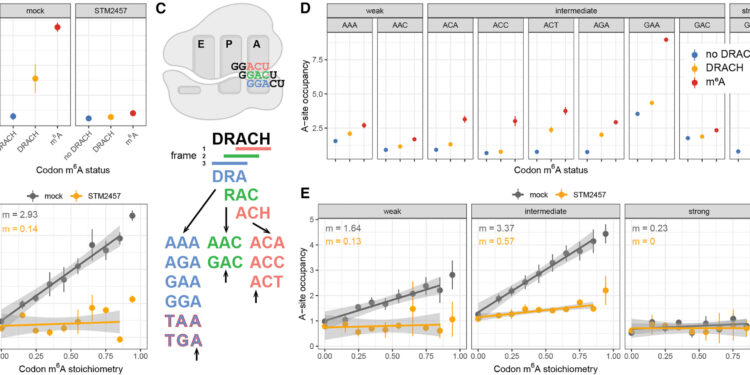M6An elongated ribosomes break. Credit: Cell (2025). DOI: 10.1016 / J.Cell.2025.04.013
According to a study by a study by a study by a study by a study by a study conducted by a study led by We Medici Medici Medicine Inarketers. The discovery clarifies an important aspect of cell biology and can have clinical implications, because this modification of the messenger RNA, known as m6A, is the target of an emerging class of cancer treatments.
Messant RNA (mRNA) – The molecule that carries genetic instructions to make proteins – is often marked with m6A, a chemical modification which acts as an “elimination label”. Messenger RNA of cell survival and reply constraint often contain much more m6Like the average messenger RNA. Under normal conditions, this label helps to break down these messenger RNAs, keeping proteins for response to the response to low levels.
In the study, published on May 5 CellThe researchers discovered surprising details on how it all works. They discovered that M6A triggers the elimination of mRNA while mRNA is read by the ribosome, the cell machine which converts the instructions of the specific protein mRNA.
They found that the ribosome is more than simply reading the mRNA – he is looking for M6A on the molecule and ensures that mRNA with the modification are targeted for degradation. Scientists then found that this elimination process was put on hold when the cell is stressed, which allows to accumulate and produce proteins that help the cell to recover.
“These results answer fundamental questions about M6R, in a way that will change the way we think of his roles in cellular stress responses and cancers, “said Dr. Samie Jaffrey, principal author of the study, professor of Greenberg-Starr in the department of pharmacology and member of the Sandra and Edward Meyer Cancer Center at Weill Cornell Medicine.
That messenger RNA frequently contain m6The A has been known since the 1970s, but the modification has not started to concentrate only in recent years, and many important questions have not been resolved.
“We knew that M6The presence of A on a messenger RNA can induce its degradation, but we did not know that M6The ARNA degradation effect was activated and deactivated to control cell physiology, “said the first author of the study, Dr Shino Murakami, Weill Cornell Medicine pharmacology instructor.
Researchers initially suspected that a cell way must deactivate the degradation effect of M6A during cell stress. To find a deactivated switch, researchers have examined a large public database that documents how mRNA levels change in cells after they are exposed to many types of chemicals and treatments.
They found that the cells exposed to compounds that inhibit ribosomes had unusual levels of M6The messenger RNA containing A, which are normally weak. This involved ribosome in the mRNA degradation process with m6A.
This achievement led them to discover a series of unexpected events: they found that the ribosome stops mainly when it meets a m6A on a messenger RNA. Under normal cellular conditions, another ribosome can happen on the same RNA before the first passes before the M6A, causing the collision of the two ribosomes.
These “accidents” are in fact significant events, attracting M6Reading proteins A which triggers the elimination of RNA. In this way, stress response proteins coded by M6Modified mRNAs A are mainly prevented from being produced under normal and non -stress conditions.
On the other hand, during periods of cell stress, when ribosomal activity is generally reduced, fewer ribosomes are available to collite. Thus, M6ARNA containing has accumulated and can be converted into stress response proteins.
“Them6A way normally helps to remove stress responses in cells, but we knew that there should be a switch that turns it off during cell stress, and it turns out that ribosome is an essential element of this switch, “said Dr. Jaffrey.
The results may have implications for therapies against cancer. The emerging field of anti-M6A treatments, which operate by inhibiting Mettl3, the enzyme which catalyzes the formation of M6A on mRNAs, are tested in clinical trials. This study raises the possibility that these drugs work by inducing the expression of stress response proteins, which are known to block the growth of certain cancer cells.
“Our new discovery suggests strategies to predict the types of cancer that will respond to METTL3 inhibitors, which could help us identify patients who best meet this therapy,” said Dr. Jaffrey.
More information:
Bastian Linder and Al, changes to the AR adjust the disintegration of mRNA dependent on M6A, Cell (2025). DOI: 10.1016 / J.Cell.2025.04.013
Newspaper information:
Cell
Supplied by Weill Cornell Medical College
Quote: How a tiny modification of RNA helps to control the responses of cellular stress (2025, May 5) recovered on May 5, 2025 from
This document is subject to copyright. In addition to any fair program for private or research purposes, no part can be reproduced without written authorization. The content is provided only for information purposes.



